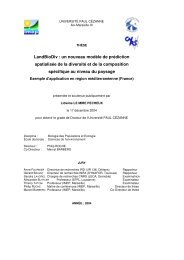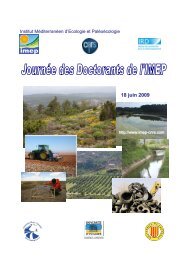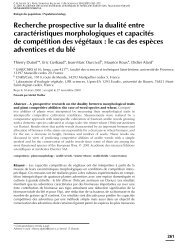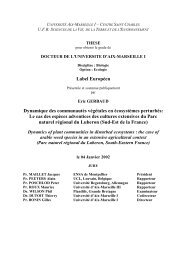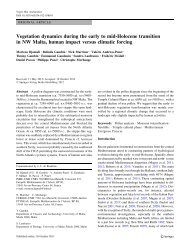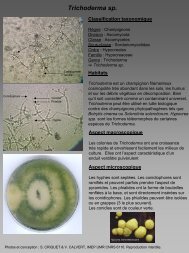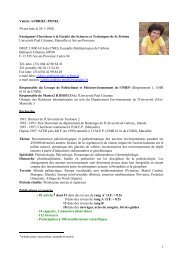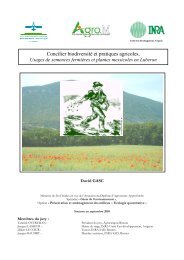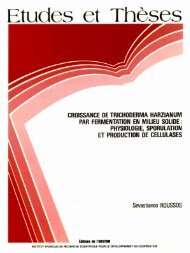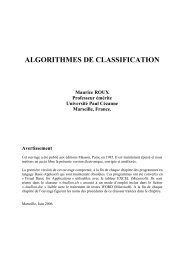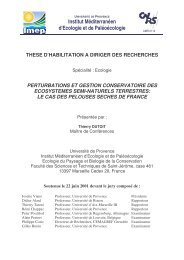UNIVERSITÉ PAUL CÉZANNE, AIX MARSEILLE III - IMEP
UNIVERSITÉ PAUL CÉZANNE, AIX MARSEILLE III - IMEP
UNIVERSITÉ PAUL CÉZANNE, AIX MARSEILLE III - IMEP
You also want an ePaper? Increase the reach of your titles
YUMPU automatically turns print PDFs into web optimized ePapers that Google loves.
1. Introduction<br />
Résultats et discussion. Chapitre 5: Disponibilité des substrats oléicoles<br />
Mediterranean basin concentrates 97% of the world olive oil production (Ismaili-<br />
Alaoui, 2006). Two technologies exist for oil extraction, the oldest three-phase and the more<br />
recent two-phase. The three-phase which generates two wastes (olive mill wastewater and<br />
olive cake) remains the dominating technology in the south of the Mediterranean bassin. It is<br />
estimated that some 3x107 m3 of olive mill wastewater, accompagnied by 5x105 tons of olive<br />
cake are generated each year as a result of olive oil production and this in a very short time of<br />
4 months (November to February) (Gögüs and Maskan, 2006). With a production of 50,000<br />
tonnes of olive oil per year, Morocco is presently located at the sixth rank of the world olive<br />
oil producers. Fifty percent of this production still comes from traditional mills commonly<br />
called “Maasra” which use the classic “three-phase system” with the technique of pressing.<br />
Due to its residual oil content (10-30 % w/w) which depends on the extraction<br />
technology and also to its other components, olive pit (42-54% w/w), skin (10-11% w/w) and<br />
pulp (21-33% w/w) (Lopez-Villatta, 1998), OC has been the subject of many valorization<br />
studies. To cite some of them, it has been evaluated for instance as animal feed (Haddadin et<br />
al., 2002), as raw material for glycolipids’ biosynthesis (Bednarski et al., 2004), as<br />
combustible in traditional furnaces of small building material factories (pottery works, brick<br />
manufactures, etc.) (Masghouni and Hassairi, 2000) and as substrate for mushroom<br />
cultivation (Zervakis et al., 1996) or enzyme production (Cordova et al., 1998). In a country<br />
such as Morocco, its main use is still limited to the recovery of oil by extraction with hexane<br />
for the production of soap (Serghini et al., 2007). The de-oiled OC which has excellent<br />
calorific properties is usually reused directly as combustible by the OC oil extraction units to<br />
dry OC to 6-10% (w/w) humidity before the extraction step. As a consequence, OC should<br />
not be considered as a waste and it is actually rarely dumped into the environment.<br />
Contrary to OC, OMW which contains high concentrations of toxic phenolic<br />
compounds (Di Serio et al., 2008) and organic matter (100-200 g COD/l) is extremely<br />
hazardous for the environment especially the water bodies. Until recently in Morocco, for<br />
instance the potabilization plants furnishing the water to the city of Fes, which concentrates<br />
40% of the country olive oil extraction capacities, had to be put out of operation during the<br />
olive milling campaigns. This was due to the worsening of the Sebou river water quality<br />
resulting from the direct discharge of OMW (Foutlane et al., 2002). Owing to economic<br />
constraints, up to now, no widely accepted solutions exist for the disposal of this waste.<br />
129



